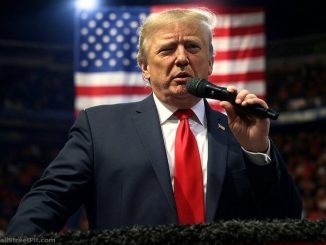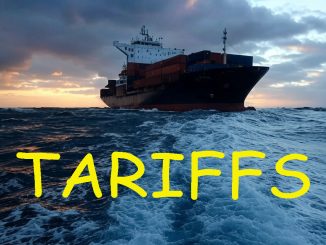- China’s 84% tariff on U.S. goods and the U.S.’s 104% tariff on Chinese imports have escalated global trade tensions, causing Dow Jones Industrial Average futures to drop 843. points, or 2.23%, with S&P 500 and Nasdaq-100 futures falling 1.15% and 0.7%, respectively.
- Major U.S. companies like Nvidia, trading at $96, Apple at $169.58 with a 1.65% decline, and Tesla at $220.96 are reflecting market strain, compounded by Canada’s 25% retaliatory tariff on U.S.-made vehicles.
- Analyst Andy Laperriere predicts tariffs may remain historically high despite potential minor deals, signaling prolonged economic disruption as global supply chains and corporate earnings face mounting pressure.

The global trade landscape has entered a turbulent phase as escalating tensions between major economies triggered sharp declines in stock futures on Wednesday. China’s announcement of an 84% tariff on U.S. goods, set to take effect on Thursday, sent shockwaves through financial markets, exacerbating an already fraught situation following the U.S. imposition of a 104% tariff on Chinese imports just after midnight on Wednesday. This tit-for-tat escalation reflects a broader deterioration in trade relations, with the Dow Jones Industrial Average futures plunging 843 points, or 2.23%, while S&P 500 futures fell 1.15% and Nasdaq-100 futures retreated 0.7%. The numbers paint a stark picture of investor unease as the economic ramifications of these policies begin to unfold.
The roots of this latest clash lie in the Trump administration’s decision to follow through on its threat to impose a 50% tariff on Chinese goods, layered atop an existing 34% reciprocal tariff, culminating in the 104% rate now in place. China’s swift retaliation with its 84% levy underscores the deepening rift between the world’s two largest economies. Beyond this bilateral skirmish, the U.S. has also extended steep duties to 184 other trading partners, effective as of 12:01 a.m. ET on Wednesday, amplifying the scope of disruption. Meanwhile, Canada has joined the fray, reaffirming its commitment on Tuesday to impose 25% retaliatory tariffs on U.S.-made vehicles. This measure targets both non-compliant vehicles under the United States-Mexico-Canada Agreement and non-Canadian, non-Mexican content in USMCA-compliant vehicles imported from the U.S., further complicating North American trade dynamics.
Equity markets are feeling the strain, with prominent U.S. companies reflecting the broader downturn. Nvidia (NVDA) shares have dipped below the $100 mark, last trading at $96 in premarket activity, a notable decline for the tech giant. Apple (AAPL), another heavyweight, saw its stock drop 1.65% to $169.58, while Tesla (TSLA), already down nearly 5% in the prior session, slid further to $220.96. These movements suggest that investor confidence is wavering as the tariff war threatens corporate earnings and supply chains, particularly for technology and automotive sectors heavily reliant on global trade networks.
Piper Sandler analyst Andy Laperriere offered a sobering outlook, suggesting that while tariffs may eventually ease from their current peaks, they are likely to remain elevated—at levels unprecedented in recent decades. His assessment points to a near-term risk of further increases, though he leaves room for the possibility of minor deals to temper the situation. This perspective aligns with the broader economic reality: tariffs at these heights disrupt not only bilateral trade but also global supply chains, inflationary pressures, and consumer prices. The 104% U.S. tariff on Chinese imports and China’s 84% countermeasure are poised to ripple through industries, from manufacturing to retail, as businesses grapple with higher costs and shrinking margins.
Canada’s 25% tariff on U.S. vehicles adds another layer of complexity, targeting a sector already navigating post-pandemic recovery and shifting trade rules under the USMCA. This move signals that the tariff conflict is not confined to U.S.-China relations but is spilling over into alliances, challenging the stability of regional trade frameworks. As stock futures reflect immediate market sentiment the longer-term implications remain uncertain. Investors are bracing for a period of heightened volatility, with ‘Mag 7’ names serving as barometers of the broader economic strain.
The interplay of these tariffs -104% from the U.S., 84% from China, and 25% from Canada – marks a significant shift in global trade policy, one that could redefine economic relationships for years to come. While markets react with sharp declines, the underlying question is how sustainable this escalation proves to be. For now, the data is clear: a 2%-plus drop in Dow futures and parallel slides in other indices signal a rocky road ahead as nations dig in for a prolonged trade standoff.
WallStreetPit does not provide investment advice. All rights reserved.
- Bulenox: Get 45% to 91% OFF ... Use Discount Code: UNO
- Risk Our Money Not Yours | Get 50% to 90% OFF ... Use Discount Code: MMBVBKSM
Disclaimer: This page contains affiliate links. If you choose to make a purchase after clicking a link, we may receive a commission at no additional cost to you. Thank you for your support!




